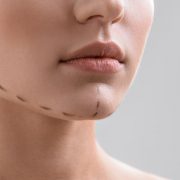Chin Surgery
Chin surgery which is known as genioplasty is a procedure to improve the shape or position of your chin. It is often performed along with other jaw surgery.
What is genioplasty?
Genioplasty is a type of surgery which will be done on the chin. Both plastic surgeons and maxillofacial surgeons can perform this type of surgery. This surgery is most frequently a cosmetic surgery, meaning people choose to have it for looks and not because of a medical problem. For this reason, it’s often not covered by insurance.
There are several ways to conduct this procedure:
- advancement, or moving the chin forward
- pushback, or moving the chin backward
- side-to-side, which can help with asymmetrical chins
- vertical changes, such as making the chin longer or shorter
Who is a Good Candidate for Genioplasty?
Not everyone unhappy with their chin can be a good candidate for genioplasty.
The best candidates tend to:
- Be in good general health
- Have a small or receding chin without a large overbite
- Have a chin which is disproportionately long
- Have an asymmetrical chin
In some cases of a retruding chin, patients may benefit more from advancing the lower jaw rather than just the chin. It will be helpful to arrange a meeting with an orthodontist to discuss alignment of the teeth before the jaw is advanced.
The genioplasty procedure
There are two main types of genioplasty surgery that can be performed according to what the patient would like to achieve. These are sliding genioplasty and chin implant surgery.
Sliding Genioplasty
As with both forms of genioplasty, an incision is made inside the mouth as to not allow visible scarring on the face. Your surgeon will cut the bone on the chin and re-position it. Once in place, it will be held in its new position with small plates and screws. The mouth will be stitched up and the patient can begin the recovery process.
Sliding genioplasty is an effective technique to help correct severe retrogenia (it is a condition when the chin is placed too far back in relation to the rest of the facial structure). This technique can also help correct chins that are too far forward or too long.
Chin Implants
Surgical chin implants may be chosen for those who wish to enlarge of push forward the appearance of the chin. Essentially, a small piece of biocompatible plastic material is inserted into the chin, integrating with the bone.
Genioplasty surgery recovery
Lots of patients are pleasantly surprised to find out that genioplasty is not a particularly painful procedure. Your surgeon will prescribe the appropriate pain medication, as you will still experience discomfort in the days following surgery. Pain and swelling should completely dissipate over the course of a few weeks. To ensure that the risk of infection is minimized, you will also be given a course of antibiotics.
You should help to reduce swelling by applying a cold pack to the area periodically over the first few days after surgery. If you can, it is also a good idea to sleep as upright as possible.
This procedure is performed under general anesthetic, meaning that you will be required to stay in the hospital for a short period of time following surgery. You should also refrain from driving for at least 48 hours after surgery. Generally, we advise patients to take one week off work following genioplasty surgery.
Risks and Benefits of Chin Reshaping Surgery
All surgeries have inherent risks. The chin reshaping surgery is associated with the following risks:
- The patient may experience swelling for several weeks or months while the bone heals.
- Infection is a less common risk to weigh when considering chin plastic surgery.
- Small nerve damage, which can cause the patient to experience numbness in the lower lip and chin.
- Adverse reactions to anesthesia, which can affect a patient’s respiratory system.
Though the risks may be significant and important to consider, the likelihood of complications is greatly reduced when chin reshaping surgery is performed by an experienced surgeon. In careful, skillful hands, a chin reshaping surgery can improve the appearance of your chin and enhance your self-esteem. A chin reshaping can create a more harmonious balance between your nose and your chin as it creates a more equal proportion between the two. Performed in conjunction with a facelift and rhinoplasty, a chin reshaping procedure can be the final element in creating an elegant, beautiful appearance.
CHIN AUGMENTATION FAQ
Is it obvious when someone has a chin augmentation?
A chin augmentation is a very common procedure. When was the last time you saw someone and thought they had a chin implant? Those of us with “Jay Leno chins” were born that way. While plastic surgeons may overdo breast implants, the same probably cannot be said about chin implants. The results of a chin implant are subtle but profound.
If I don’t like my chin implant, can it be removed?
Most patients love their chin implant and never want it removed. But there are some patients who may have never needed it and want it gone. Removing a chin implant is a relatively straightforward procedure and usually proceed without a problem. But there are some cases in which the implant created a little depression in the bone beneath it, so that after the chin implant is removed the patient has less overall chin projection than they originally had.
Are the results of a chin augmentation permanent?
The chin will look augmented as long as the implant remains in place.
How long does a chin implant last?
A chin implant never needs to be replaced. Unlike a breast implant, a chin implant is solid; there is nothing to leak out of it. Most people have one chin implant and it will last them a lifetime.
What is a sliding genioplasty?
A sliding genioplasty is an operation in which the jaw bone is cut and the lower portion is slid forward and held into place with screws. It is an alternative to a chin implant.









Leave a Reply
Want to join the discussion?Feel free to contribute!